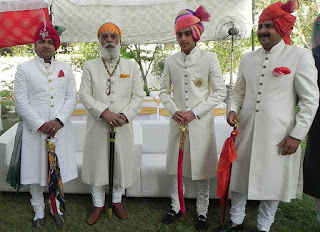- TRADITIONAL COSTUME
A saree or sari is a female garment in the Indian subcontinent. A sari is a strip of unstitched cloth, ranging from four to nine meters in length, that is draped over the body in various styles. These include: Sambalpuri Saree from East, Mysore silk and Ilkal of Karnataka and, Kanchipuram of Tamil Nadu from South, Paithani from West and Banarasi from North among others. The most common style is for the sari to be wrapped around the waist, with one end then draped over the shoulder baring the midriff.
An Achkan or a Sherwani is a long coat / jacket that usually sports exposed buttons through the length of the jacket. The length is usually just below the knees and the jacket ends just below the knee. The jacket has a Nehru collar, which is a collar that stands up. The Achkan is worn with tight fitting pants or trousers called churidars.
- TRADITIONAL FOOD
Biryani
An aromatic rice dish cooked with several spices, notably saffron, and a protein (typically chicken or mutton) that’s been marinated.
Momos
A variation on the traditional dimsum, native to the North Eastern states that border Nepal (where the dish originated), eaten with a fiery red chutney.
- Tourist Place
Lake Palace
The Lake Palace in Lake Pichola in the city of Udaipur was built as a royal summer palace in the 18th century. Today it is a luxury 5 Star hotel, operating under the “Taj Hotels Resorts and Palaces”. The Lake Palace hotel operates a boat which transports guests to the hotel from a jetty at the City Palace on the east bank of Lake Pichola.
Harmandir Sahib
The Harmandir Sahib, better known as the Golden Temple is the main tourist attraction in Amritsar, and the most important religious place to the Sikhs. Construction of the temple was begun by Guru Ramdas ji. in the 16th century. In the 19th century, Maharaja Ranjit Singh the upper floors of the temple were covered with gold.
Taj Mahal
The Taj Mahal in Agra is an immense mausoleum of white marble, built between 1632 and 1653 by order of the Mughal emperor Shah Jahan in memory of his favorite wife. Called “a teardrop on the cheek of eternity” it is one of the masterpieces of Mughal architecture, and one of the great tourist attractions in India.
Written by Samuel Figueroa.







No hay comentarios:
Publicar un comentario